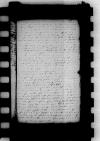Post abitum ⌊hinc⌋ Dominationis Vestrae Reverendissimae venit huc dominus ⌊Hermannus a Bremen⌋ allegatus ab heredibus ⌊reverendissimi olim domini Mauritii episcopi Varmiensis⌋, multaque mecum ratione testamenti in iis, quae et nobilis dominus ⌊Ioannes a Verden⌋[1] ad me scripsit, suis nixus persuasionibus egit, verum non persuasit, ususque sum ad eum hoc argumento: Do tibi omnia, quae habeo ⌊Romae⌋, ⌊Gdani⌋ et alibi, non ms. nom(!)
⌈nonnon ms. nom(!)
⌉ igitur acciperet ms. actiperet(!)
⌈acciperetacciperet ms. actiperet(!)
⌉ ea, quae hic habeo, quod enim alibi est, hic non est. Ad hoc dissolvendum retulit se rursum ad castrum ⌊Preuschmarckt⌋, unde instructus venerat, obtinuit tamen ad dominos testamentarios litteras[2] a me eius tenoris, cuius est iis adiuncta copia, quae si reddetur, sciet Dominatio Vestra Reverendissima cum aliis suis collegis, quid facere debeat. Ad ea frater Dominationis Vestrae Reverendissimae[3], qui mille apud me aureos Hungaros reliquit, ex ⌊Preuschcmarckt⌋, ubi adhuc ⌊dominum Hermannum⌋ offendit, nullum responsum ⌊⌋, reportavit. Quid moliantur,
ms 1 moliancium,
ms 2 3 4 moliamur⌈molianturmoliantur,
ms 1 moliancium,
ms 2 3 4 moliamur⌉ experiemur brevi. Hodie hinc Dominationis Vestrae
Reverendissimae frater[4] ad ⌊dominum a Werden⌋ revertitur, ut fortassis ex eius litteris clarius intelliget. Rediit item et nuntius meus, quem ex ⌊Graudencz⌋ cum ⌊⌋ miseram. Quid
rescriptum sit, ex adiuncto litterarum exemplo Dominatio Vestra Reverendissima habebit. Mitto et litteras ⌊reverendissimi domini Cracoviensis⌋[5] communisque amici nostri ⌊domini Nipschicz⌋[6], quas metiri seu expendere oportet non quales sunt, sed qualis sit homo, qui scripsit; quod si Dominationi Vestrae Reverendissimae cognitum non esset, retinuissem. ⌊Frater meus Bernardus⌋ rediens ex ⌊Toronia⌋ cum ⌊domino Iacobo Ludovici⌋ sic convenit, quod pecuniae nostrae[7] apud illum numeratae consignataeque maneant,
significetque suis litteris domino ⌊Georgio Hegel⌋, quod istiusmodi summa apud se reposita sit, ut commodo tempore cum fraternis pecuniis ⌊Cracoviam⌋ mittantur. De quibus cum sic ⌊Georgius Hegel⌋ certus factus fuerit, securius dominis suis ut ⌊Romae⌋ reddantur scribere possit. Ea missio visa mihi est longe tutior quam illa, quam prius conceperamus. Curabo itaque, ut quam primum ⌊frater meus Bernardus⌋ melius ex impetigine, quae illi iis diebus ex exanthematis et,
ms 1 anthematis et,
ms 2 3 4 omitted⌈exanthematis etexanthematis et,
ms 1 anthematis et,
ms 2 3 4 omitted⌉
pusulis or papulis,
ms 1 2 3 4 pupulis⌈pusulispusulis or papulis,
ms 1 2 3 4 pupulis⌉ erupit, habuerit, {ut} pecuniis nostris ⌊Thoronia⌋e relictis quantum potest citius ⌊Cracoviam⌋ se conferat, et cum ⌊Georgio Hegel⌋ in
omnibus negotia nostra absolvat. Quod si ⌊dominus cancellarius episcopus Cracoviensis⌋ {non} aberit ad ⌊serenissimum forsan Romanorum regem⌋ ablegatus, aget nihilominus ⌊frater meus⌋ aliorum amicorum meorum opera apud ⌊dominum vicecancellarium⌋, quod litterae a Dominatione Vestra Reverendissima praescriptae ad ⌊pontificem⌋ a ⌊maiestate regia⌋ dabuntur. Alia in praesens non restant, quam quod Dominationem Vestram Reverendissimam felicissime bene valere cupio. ⌊Domino Felici⌋ communi amico nostro omnibusque bonis fratribus nostris omnia fausta precor. Scripsi fere in ipso meridie, tanta fuit caligo, ad lucernam.
 BCz, 244, p. 282
BCz, 244, p. 282
